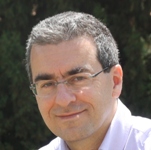|
|
Charis Gantes
 Charis Gantes is Professor and Director of the Institute of Steel Structures, at the
School of Civil Engineering,
National Technical University of Athens.
Charis Gantes is Professor and Director of the Institute of Steel Structures, at the
School of Civil Engineering,
National Technical University of Athens.
He is active in teaching, research and practice of structural engineering, with emphasis on the behavior, analysis and design of steel structures:
- He teaches and coordinates the undergraduate courses "Steel structures I", "Steel structures II" and "Nonlinear behavior of steel structures", and the graduate courses
"Design of cable and membrane structures" and "Steel structures for marine applications". He supervises doctoral, graduate and undergraduate students working in the above fields.
- His research activities cover aspects of behavior, analysis and design of structures under extreme loading including seismic, wind and blast,
causing them to respond in nonlinear manner, with emphasis on steel structures. Objective of his research is to evaluate the ultimate strength of members, connections and structures, combining
experimental, numerical and analytical methods, mostly nonlinear finite element analyses. He is particularly interested in steel structures for energy applications,
such as wind turbine towers and buried pipelines, as well as in the structural condition assessment of old steel structures.
- He is author of a book on deployable structures, a book on nonlinear behavior of steel structures, class notes for a graduate course on cable structures,
and he has co-authored a book on applications of special issues in structural steel design. He edited a collective volume and parrticipated in two more, and he is co-author of 10 book chapters,
120 technical papers published in international journals, and approximately 200 technical papers published in proceedings of international conferences. His research work has significant international recognition,
as demonstrated by the number of citations and the value of h-index.
- He is Editor-in-Chief of the Journal of the International Association for Shell and Spatial Structures, Associate Editor of Frontiers in Built Environment - Earthquake Engineering,
Review Editor of Frontiers in Built Environment - Structural Sensing, Member of the Editorial Board of the International Journal of Space Structures and
Correspondent for Greece of Structural Engineering International (SEI).
- He contributes to improving the know-how of Greek structural engineers in issues related to the design of steel structures by participating in working groups and project teams developing
pertinent structural design codes and by teaching in continuing education seminars. He is member of the Greek mirror Committee of CEN/TC250, ELOT/TE67 Committee on "Eurocodes", Coordinator
of the Greek mirror Group of CEN/TC250/SC3, ELOT TE67/OE3 "Eurocode 3" and representative of Greece in Committee CEN/TC250/SC3 for Eurocode 3 of the European Committee for Standardization, CEN.
He was member of CEN Project Teams SC3/T1 and SC3/T11 for parts EN1993-1-1 (General rules and rules for buildings) and EN1993-3 (Masts, towers and chimneys) of Eurocode 3 in the framework of
the development of the second generation of Eurocodes.
- He participates as a consultant in the structural design of buildings and other technical projects, mostly made of steel, but also of other structural materials, in Greece and abroad, including
long-span steel roofs, power plant facilities, wind turbine towers, transmission and guyed towers, buried pipelines transporting oil and natural gas,
marine facilities, underground structures including subway tunnels and stations, road infrastructure projects, temporary supports of deep excavations and a wide range of buildings.
He is trying to keep proper balance between theory and practice, which he considers an essential attribute of a "good engineer". He believes that this is the most important message that he can convey
to his students. Accordingly, he is trying to follow the recommendations in the ASCE Civil Engineering Body of Knowledge,
American Society of Civil Engineers, Civil Engineering Body of Knowledge for the 21st Century: Preparing the Civil Engineer for the Future, 2nd edition, 2008
regarding the four characteristics that civil engineering faculty should have:
- Be a scholar
- Be an effective teacher
- Have relevant practical experience
- Be a positive role model
One of his favorite books is
The Tower and the Bridge: The New Art of Structural Engineering, Princeton University Press, 1983, by David P. Billington,
introducing the concept of structural design as a form of art. The author, formerly a Professor in the Department of Civil Engineering at Princeton University, states:
"My major objective in this book is to define the new art form of structural engineering and to show that numerous engineering artists are creating
such works in the contemporary world. The disciplines of structural art are efficiency and economy, and its freedom lies in the potential it offers
the individual designer for the expression of a personal style motivated by the conscious aesthetic search for engineering elegance".
top

|
 |